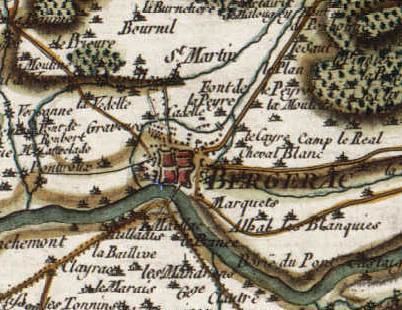England France Result Anglo-Gascon victory | Start date August 1345 | |
 | ||
1200 men-at-arms (of which 700 were Gascons), 1500 Longbowmen, 2800 Gascon Infantry 1600 men-at-arms, unknown number of infantry unknown 600 men-at-arms, unknown numbers of infantry, plus a large number of prisoners Similar Hundred Years' War, Battle of Auberoche, Battle of Blanchetaque, Battle of Arnemuiden, Battle of Cadsand | ||
Bladestorm walkthrough pt 71 aquitaine battle of bergerac part 2
The Battle of Bergerac was fought in August 1345. An Anglo-Gascon Army commanded by Henry of Grosmont, Earl of Derby, defeated a French force under Henri de Montigny, Seneschal of Périgord, outside the walls of Bergerac, leading to the loss of the town. Along with the Battle of Auberoche later in the year, it marked in change in military balance of power in the region and was the first of a series of victories which would lead to Henry of Grosmont being called "one of the best warriors in the world" by a contemporary chronicler
Contents
- Bladestorm walkthrough pt 71 aquitaine battle of bergerac part 2
- Bladestorm walkthrough pt 70 aquitaine battle of bergerac part 1
- The Campaign
- The battle
- The Aftermath
- References
Bladestorm walkthrough pt 70 aquitaine battle of bergerac part 1
The Campaign
Edward III had determined early in 1345 to attack France on three fronts. The Earl of Northampton would lead a small force to Brittany, a slightly larger force would proceed to Gascony under the command of the Earl of Derby and the main force would accompany Edward to France or Flanders. Henry of Grosmont was appointed the King's Lieutenant in Gascony on 13 March 1345 and received a contract to raise a force of 2000 men in England, plus further troops in Gascony itself. While circumstances would dictate that the main army never reached the continent, Derby's force embarked at Southampton at the end of May. Due to bad weather, his fleet was forced to shelter in Falmouth for several weeks en route, finally departing on 23 July and arriving in Bordeaux on 9 August 1345.
Derby had with him 500 men-at-arms, 500 mounted archers and 1000 English and Welsh foot archers. There was already a small English force in the Duchy, commanded by the Earl of Stafford, Seneschal of Gascony, and the somewhat larger forces of the Gascon Lords, perhaps 1000 men-at-arms and 4000 infantry. Derby marched his force to rendezvous with Stafford at the siege of Langdon, where he took command of the combined force. Stafford had to this point pursued a cautious strategy of small scale sieges. Derby's intention was quite different. After a council of war, it was decided to strike at the major town of Bergerac, where there was an important bridge over the Dordogne River. The capture of the town, which had good river supply links to Bordeaux, would provide the Anglo-Gascon army with a forward base to carry the war to the French. It would also force the lifting of the siege of the nearby allied castle of Montcuq and sever communications between French forces north and south of the Dordogne.
The battle
Derby's army moved fast and took the French forces round Bergerac by surprise. Exactly where the battle took place is unknown. Rogers makes the case for the road between St. Aubin-de-Langais and St. Nexans. Fowler believes it was on the road from Montcuq to Bergerac. The French, either lured from Bergerac by a ruse or in the process of withdrawing from Montcuq, were caught on the road by the Anglo-Gascon army. They were subject to a barrage of English archery and struck by a charge by the Anglo-Gascon cavalry. The French were routed and a running fight now took place as they fled toward the St. Madeleine suburb of Bergerac, at the south end of the bridge. Because the pursuit was so close, it was impossible to close the gates on the Barbican at the south end of the bridge and it was overrun. The pursuers pressed on to the bridge, which was jammed with fleeing Frenchmen, now taking casualties from the English archers on the river bank. Attempts to drop the portcullis on the Barbican on the north end of the bridge were thwarted by a wounded horse falling in the gateway and the Anglo-Gascons pressed on to attack the town itself. The garrison had by this time got the gates shut, although this trapped a number of their comrades outside, to be captured or killed. The Anglo-Gascons launched an attack on the gate and damaged it by fire. It would appear they failed to carry the town immediately, though they remained in control of the bridge. The Anglo-Gascon army camped in St. Madeleine, feasting on captured food and wine
The Aftermath
Although the town was not carried immediately, its fate was sealed. Its defences were weak and old-fashioned and its main riverside defenses were seriously compromised. Within days of the battle, the town fell to a new assault. The battle and subsequent capture of Bergerac were a major victory. Prisoners included Henri de Montingny, ten other noblemen and a large number of lesser men. Henry of Grosmont's share of the ransoms and the loot from the town was estimated at £34,000, approximately four times his annual income from his lands. Strategically, the Anglo-Gascon army had secured an important base for further operations. Politically, Henry of Grosmont had shown local lords who had been undecided in their allegiance that the English were again a force to be reckoned with in Gascony.
